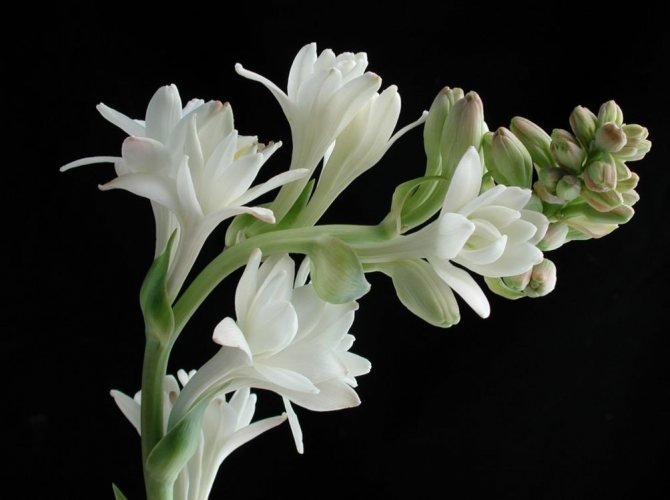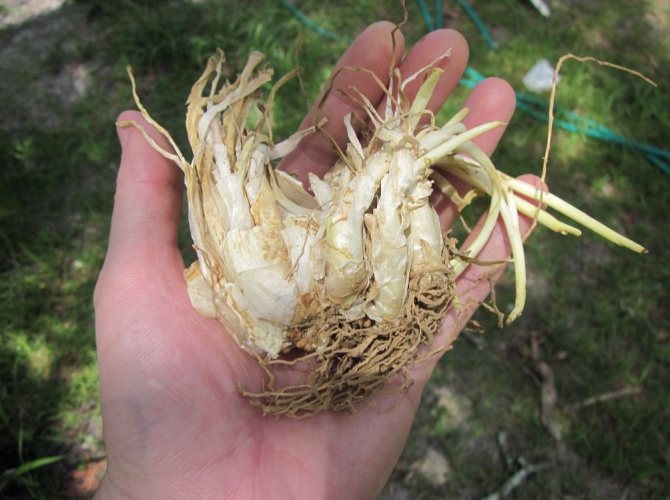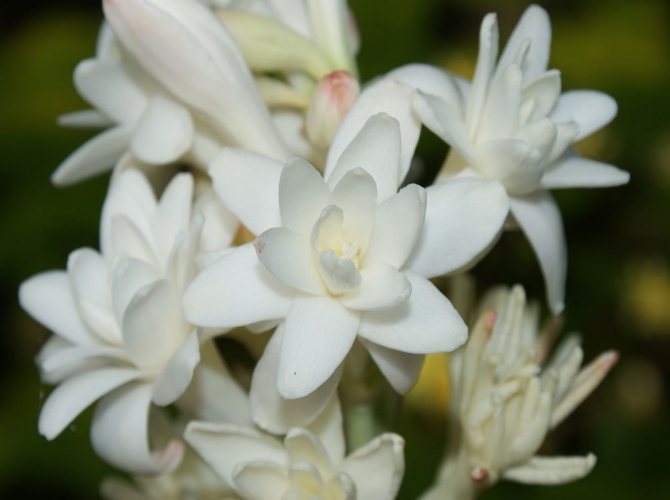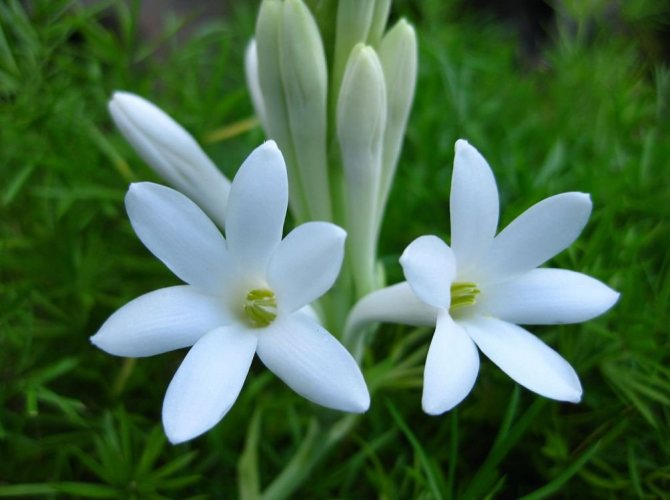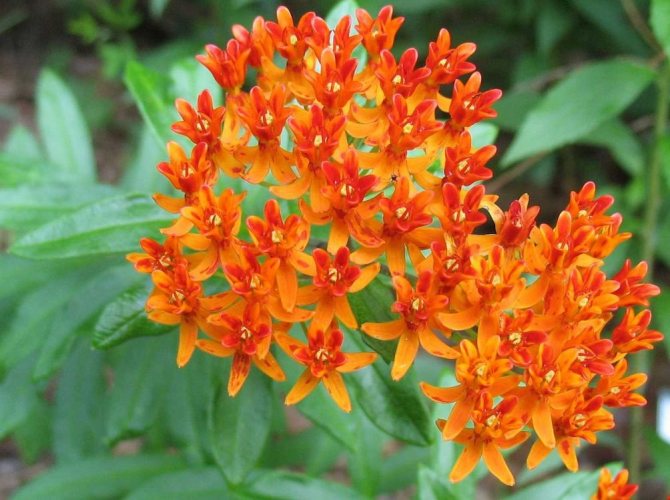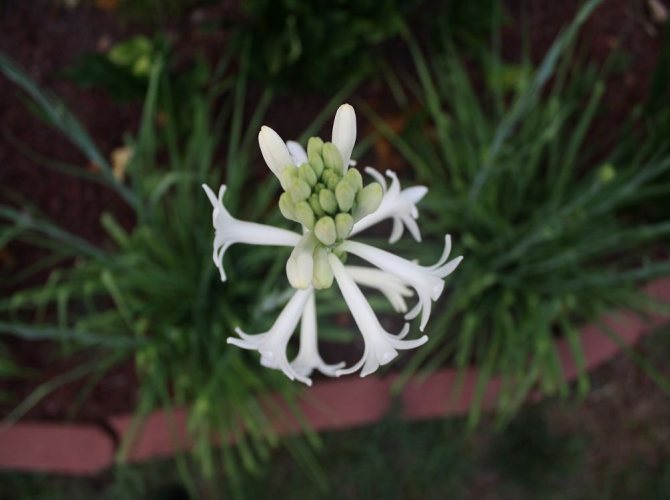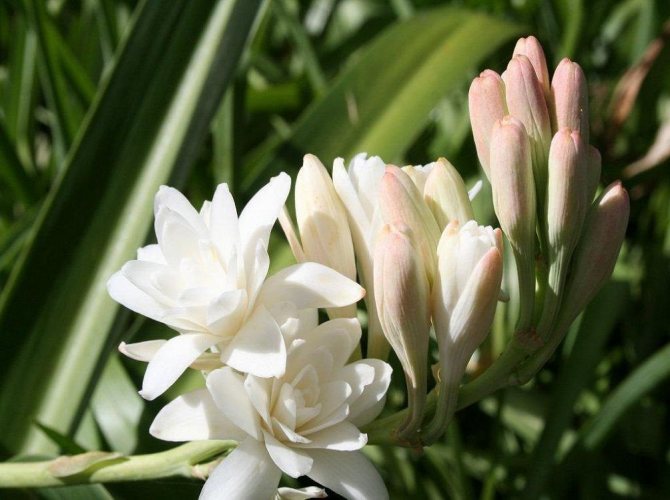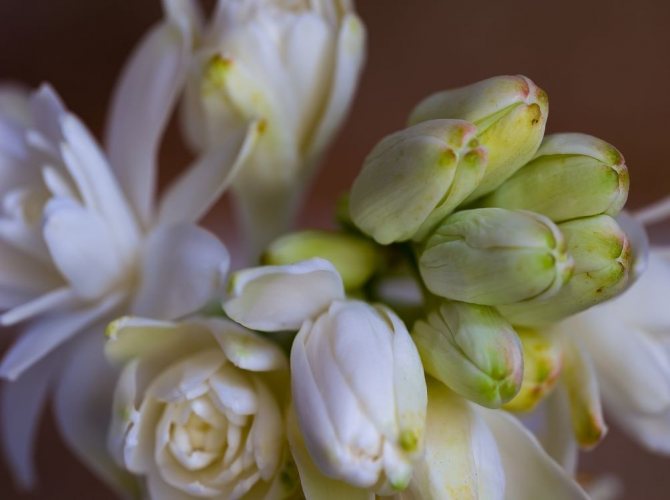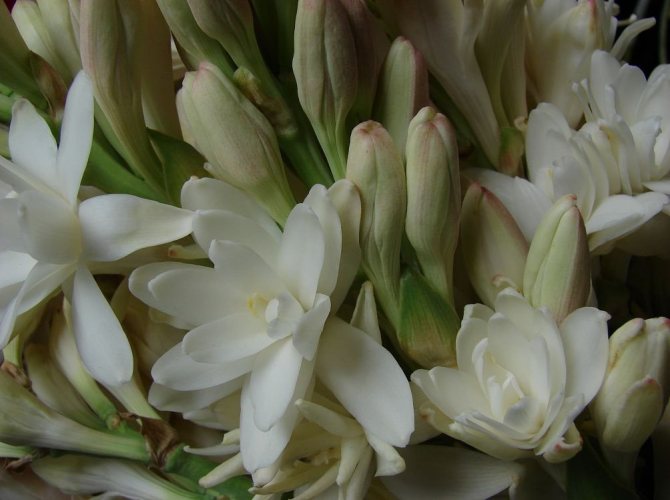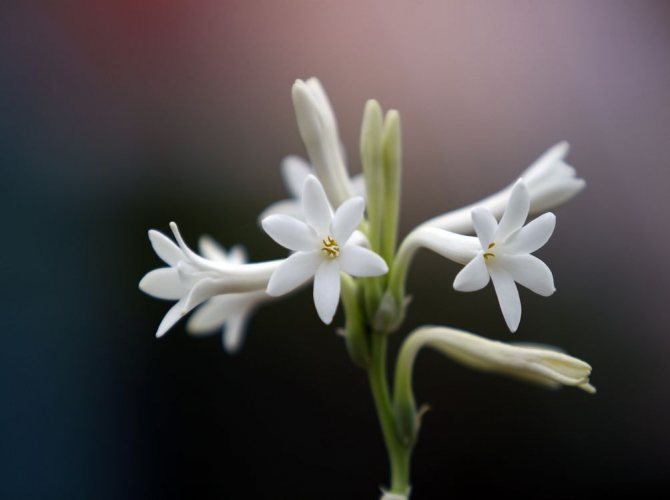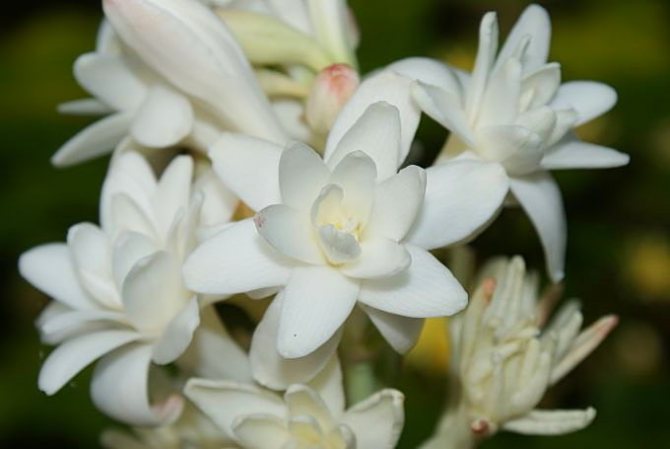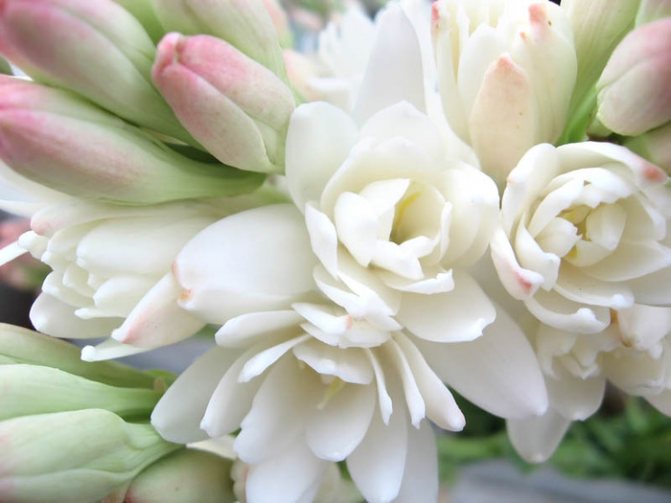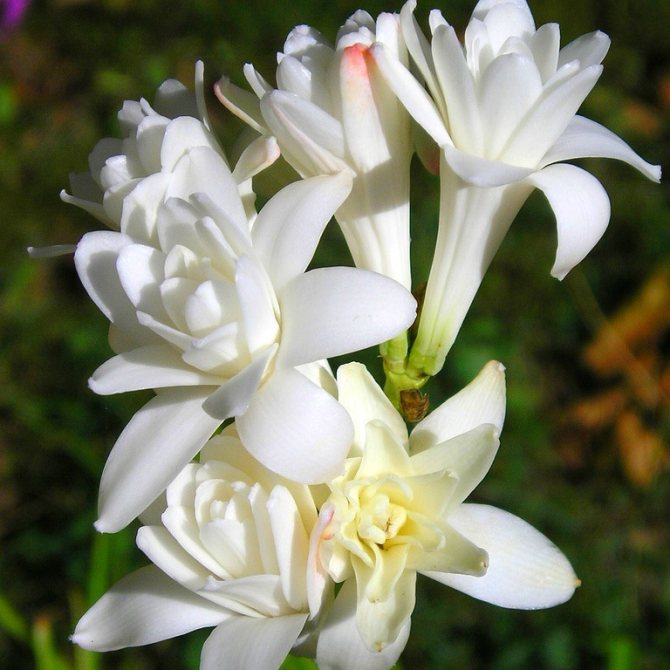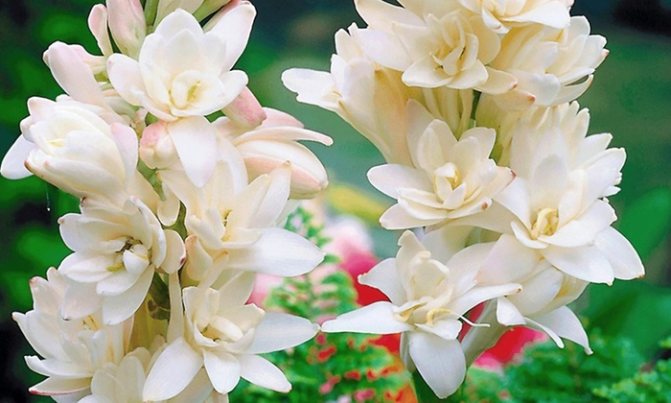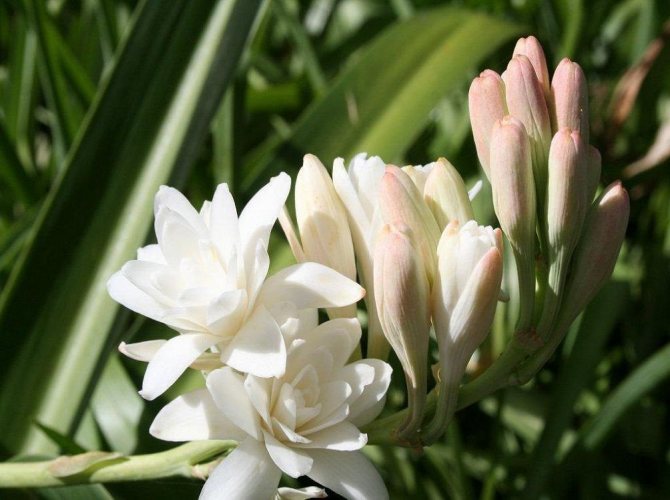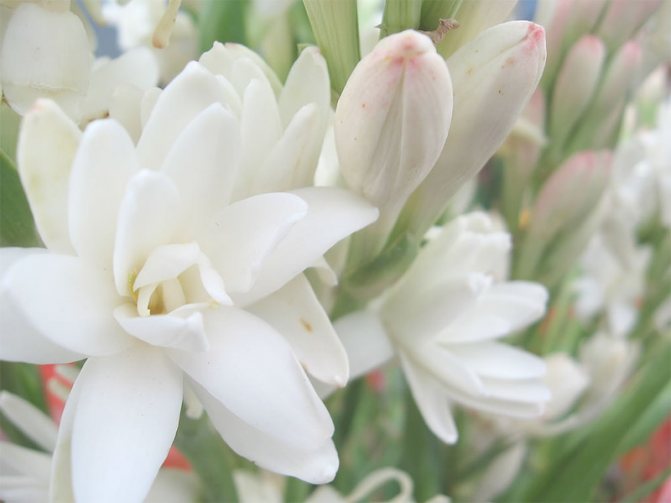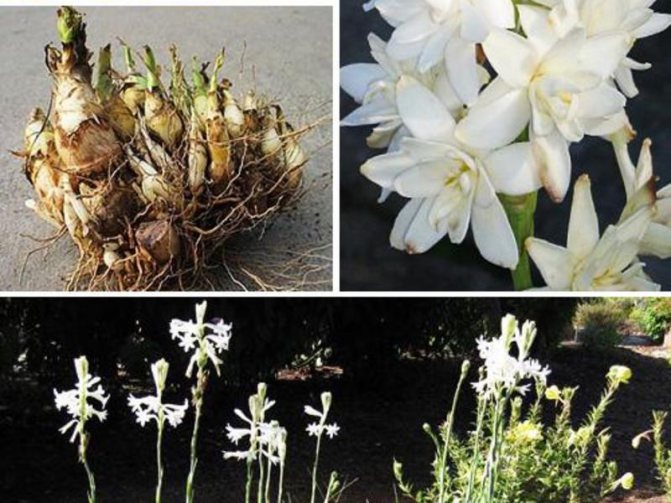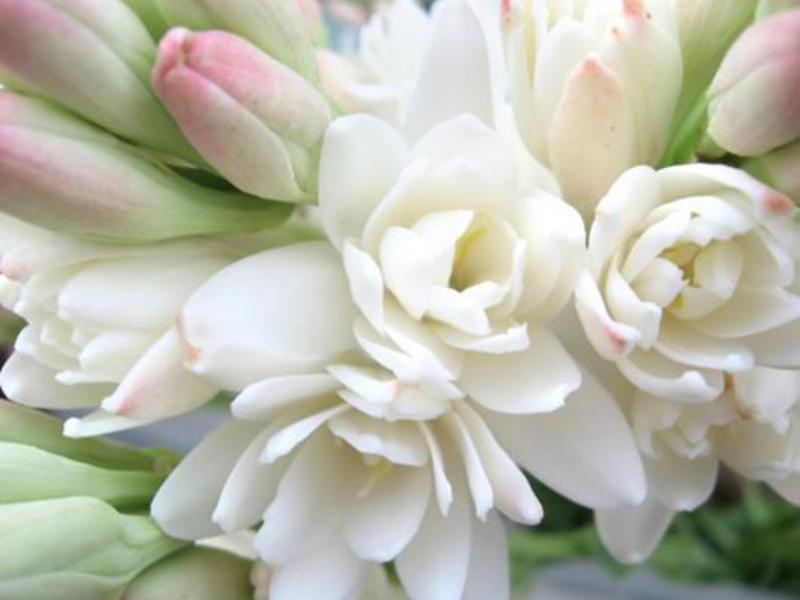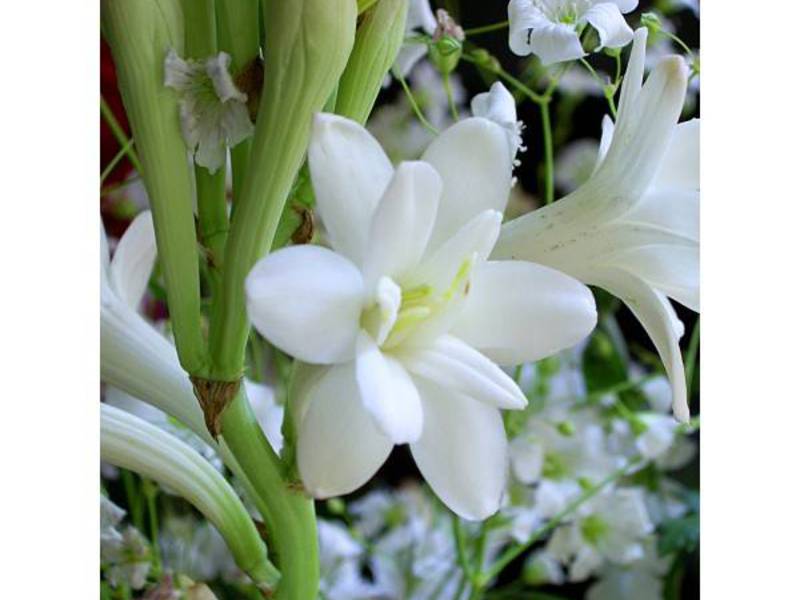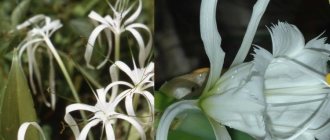The plant tuberose (tuberosa), or polyanthes (polianthes) is part of the Amaryllidaceae family, and it comes from Central America. This flowering plant is highly decorative. Its magnificent flowers have a pleasant, strong aroma that brightens in the evening. In mid-latitudes, this flower can be met infrequently, since many gardeners are afraid not to cope with such a capricious plant. But those who decided to decorate their garden plot with it do not regret it at all. Experienced gardeners say that if you take care of a plant correctly and choose a suitable site for it, it will look very impressive and bloom for a long time.
Botanical description
Not every florist has an encyclopedia of houseplants, but I would like to know some of the characteristics of especially beloved specimens. We will try to consider in detail what tuberose is. After all, the name itself, which sounds a little unusual, is of interest. Tuberose is a perennial decorative flower, the tubers of which are covered with numerous babies and a brown film. Reaches a height of 90 centimeters, but when grown at home, this figure drops slightly.
The plant has oblong narrow leaves, the number of which does not exceed 9 pieces. Most of all, they are similar to those of cereals. Their width does not exceed 2 centimeters, but the length can vary from 35 to 50 centimeters.
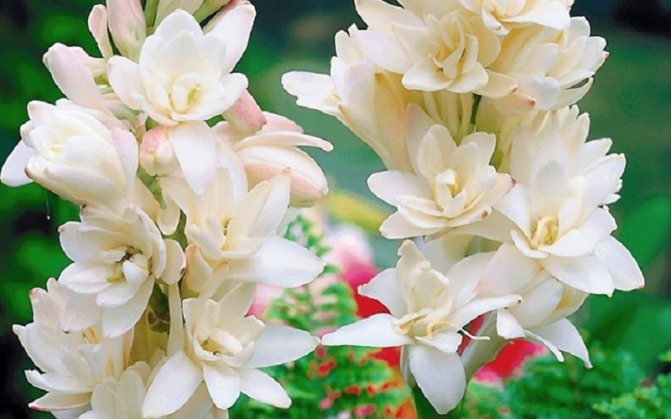
As you can see in the photo, tuberose has double, and in some cases simple flowers, which differ not only in exterior features, but also in a wonderful aroma. The spiky inflorescence can be pink or white.
Cultivation of tuberose
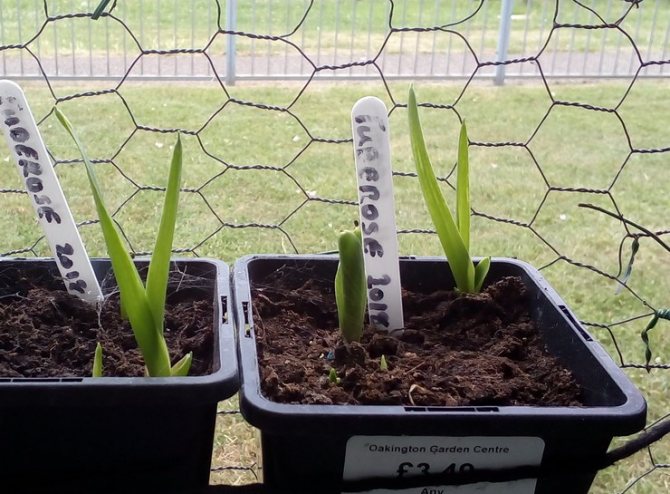

To grow tuberose, use the seed method or propagate the plant from daughter bulbs. It is quite difficult to achieve success from sowing, since the crop is very weak in the early stages of development. Without greenhouse conditions and careful care, seedlings often die, not having time to acquire even a couple of leaves.
Typically, tuberose is grown by planting the bulbs in the ground. During the season, the maternal tuber is overgrown with several dozen small children. They are detached from the bulb and grown as new seedlings. It is important to wait until the corms are fully ripe. Leaf wilting is considered a sign of ripening. Then the bush is dug out, the tuber is dried and the outlet is disconnected.
To avoid drying out of the bulbs, planting material is stored in moist moss, peat in a dark, cool place. It is not necessary to divide the nest annually, but it is still recommended to do the procedure at least every 3-4 years. Otherwise, the flowering will not be as abundant, and the bushes will become low and unattractive.
History
Wondering where the tuberose flower grows? A photo of this plant will allow you to better imagine its decorative qualities. It is most often found in Mexico and on the island of Trinidad. The southern territory is the first home to tuberose. Here, the flower feels best in open field conditions.Ever since Christopher Columbus discovered America, polyanthes (the second name for tuberose) began to be actively exported to other continents. This plant perfectly tolerates cold, as a result of which it can take root even in Asian countries. Tuberose appeared on the territory of Europe in 1632, when it was brought here directly from India.
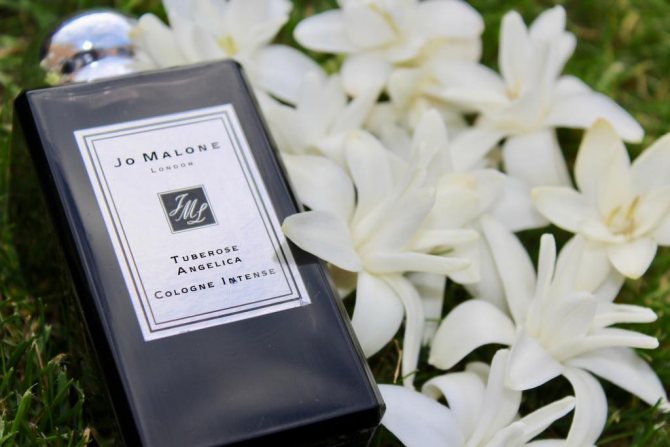

Throughout the history of its existence on new continents, the plant has had two peaks in popularity. The first fell on the Renaissance, and the second fell towards the end of the 19th century. Today tuberose is gaining popularity again. However, in the harsh climate of our country, the flower will not be able to grow year-round in the open field. The plant is distinguished by good endurance, but at the same time it is very capricious in care. Only if you follow all the rules of planting, watering, disease prevention, and so on, you will be able to enjoy the wondrous aroma of this wonderful plant.
Types and varieties of tuberose
To date, 13 types of tuberose are known. However, only 2 species are grown in culture.
Tuberose, or tuberous polyanthes (Polianthes tuberosa)
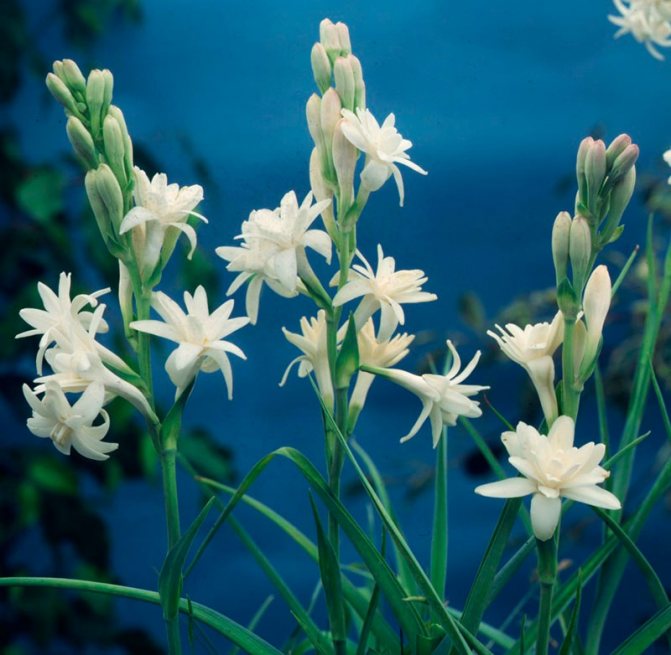

No more than nine narrow, oblong-shaped leaf plates grow on the bush. Outwardly, they are similar to the foliage of cereals. The length of the leaves varies from 0.35 to 0.5 meters, and in width they can reach from 10 to 20 mm. They form a root rosette.
Most often, highly decorative flowers in this plant are double, but they can also be simple. As a rule, they are painted white, but there are also pink ones. Flowers are part of a loose spike-shaped inflorescence. On one peduncle, from 18 to 20 flowers are formed, reaching from 40 to 60 mm in diameter.
The best varieties of this type include:
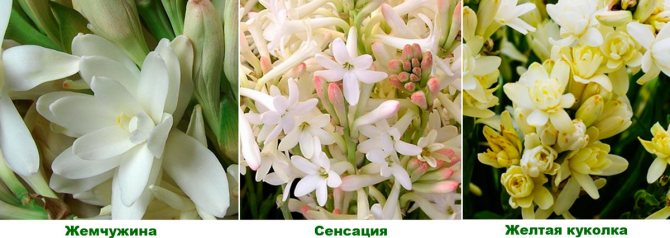

- Pearl... This medium-sized plant reaches a height of about 0.45 m. During flowering, it is decorated with spectacular large double inflorescences of a snow-white color. This variety reacts extremely negatively to cold, and therefore it is preferred to cultivate it indoors.
- Sensation... This perennial plant has funnel-shaped flowers, and they are painted in a lilac-pink hue.
- Yellow chrysalis... This plant is one of the most beautiful varieties of tuberose. Its flowers are painted in a delicate pastel yellow shade.
- Decoration... Intense pink inflorescences have a pleasant, pungent odor. This variety can be cultivated outdoors, but only in regions with mild climates. Most often, such tuberose is grown for the purpose of making perfumery, and the site is decorated with it much less often.
- Pink sapphire... The bush reaches a height of about half a meter, while it is highly decorative. During flowering, it is covered with many lush flowers. A thin lilac border runs along the edge of the light pink petals.
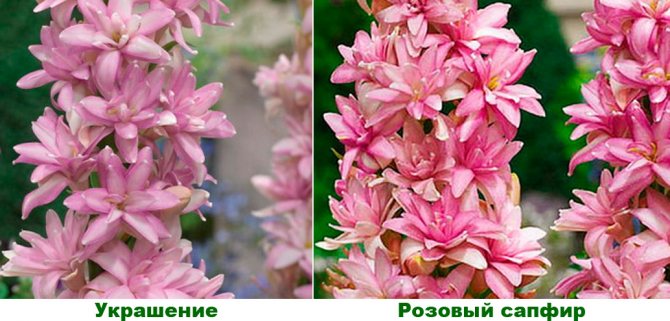

Polyantes broadleaf (Polianthes platyphillus Traub et Moldenke)
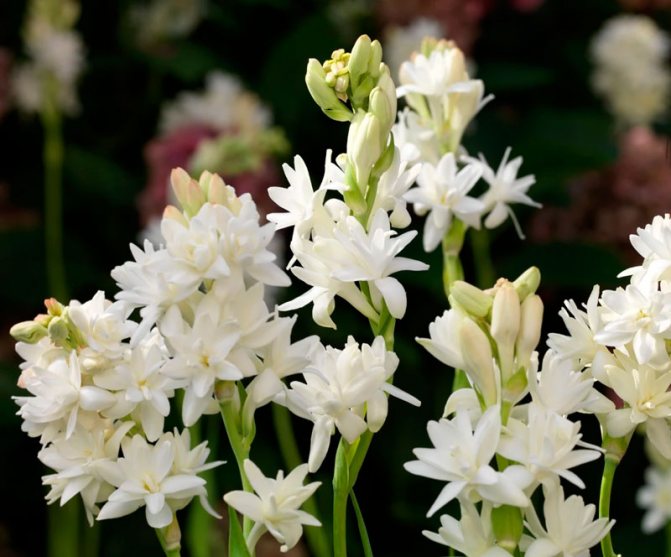

This perennial has a bulbous root system. In diameter, the corm reaches from 20 to 30 mm. The height of the dense erect stem is about one meter, its surface is bare and rough. Belt-like smooth wide leaf plates form a rosette at the base of the stem. The spike-shaped inflorescence consists of white funnel-shaped flowers, reaching from 40 to 50 mm in diameter. This plant begins to bloom in April – May. Its flowers have a very pleasant scent.
Varieties
The tuberose flower has about 13 varieties, but only 2 varieties of this flower are actively used in modern plant growing. Let's take a closer look at the representatives of the fragrant flora:
- Tuberous polyanthes is an ornamental plant that grows from 80 to 100 centimeters in height.A rosette is formed at the base of the roots, which is covered with flexible leaves reaching a length of 6 centimeters. Tuberose tubers are easily planted in the garden. Today, the smell of tuberose is actively used in perfumery. Tuberose flower has up to 30 buds in one inflorescence, which gives it a unique aroma.
- Broad-leaved tuberose has multiple bulbs that are 3 centimeters wide and 5 centimeters long. Stem erect type, densely covered with foliage at the base. The plant is characterized by bright green pigmentation on a shiny surface. The inflorescence is spike-shaped and includes several snow-white flowers that reach 4 centimeters in diameter. The generative development of the flower is considered rather weak, but its aroma does not suffer from this. You can fully enjoy it in the period from late April to early May.
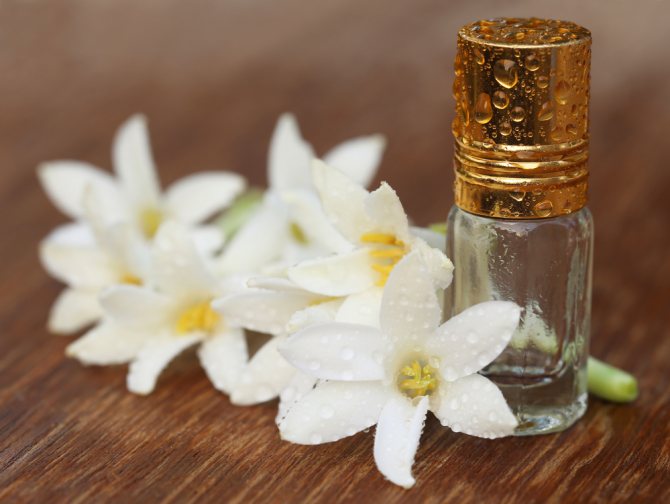

Most growers grow tuberose at home for decorative purposes, but in combination with a pleasant aroma, this plant will be an excellent decoration for almost any interior.
Description
This corm perennial has erect stems, foliage is most often alternate, wide. The flowers are collected in racemose inflorescences, the petals seem to be molded from wax. Fruits are capsules in which flat small seeds ripen.
The height of the stems ranges from 0.45 to 1.0 m, and the inflorescences are white or pink. Over time, thanks to the efforts of breeders, varieties with other petal colors - yellow, purple, violet - appeared, and the flowers themselves became double. These varieties of tuberose are very beautiful, they will decorate any garden, as they are incredibly beautiful, very fragrant, and flowering continues from the first decade of July to mid-October.
The aroma of the flowers is so strong that if you stay near tuberoses for a long time, you can get a headache.
But the aroma changes during the day. When the tuberose buds begin to bloom, they are like bells, small, delicate and very delicate.
This perennial is propagated by tubers and their children. Occasionally propagated by seed. Tuberose can be propagated by cuttings, as well as by shoots growing from lateral buds.
Germination in pots
To start breeding polyantes at home, you must first stock up on seed - corms. If you use last year's for planting, then they must be divided, since last year "kids" could have formed on them.
The best time to start growing tuberose is in February. Planting pots should be at least 15-20 centimeters in diameter. Two tubers are planted in each such flowerpot. There must be a drainage layer at the bottom of the pot. The preferred substrate for growing polyanthes is special orchid soil. You can also prepare an earthen mixture yourself by mixing in equal parts leafy earth, river sand and humus.
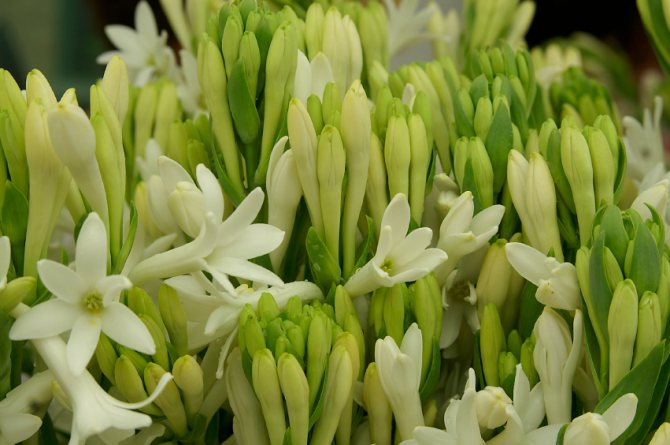

When planting tubers, try to make their tops protrude about 2 centimeters above the soil surface. Seedlings should be germinated in a warm room. Be sure to keep the soil moist at all times, but not too wet. Also, pots of bulbs can be covered with cellophane or jars to create a greenhouse effect. It is preferable to keep young shoots on the windowsill on the south side of the building.
Reproduction of tuberose
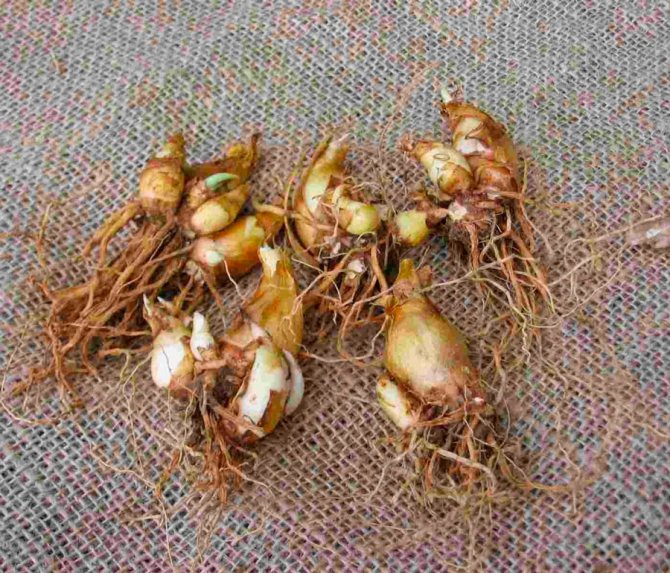

You can propagate polyanthes by seed and daughter bulbs. Such a plant is rarely grown from seeds, since this is a rather difficult task. The fact is that the seedlings that appear are very delicate, and therefore they often die in the first few days, while not even a single leaf has time to form on them.
Experienced gardeners recommend either buying new corms in the store, or propagating the bush with children. During one season, a large number of small children can form on an adult bulb. It is they who are disconnected from the mother corms and used for planting. The smallest babies will have to grow from three to four years old, and the largest ones - 1-2 years old. The bush will bloom only after its bulb in diameter is at least 35–45 mm. Before planting a large onion in the garden, you must first grow it by placing it in a greenhouse or in a warm room. Planting of bulbs in pots for growing is carried out in March. And in the spring, when the return frosts are left behind, the bush can be transplanted to a suitable site in the garden.
If your region has a temperate climate, it is best to grow tuberose in a pot. In the warm season, the bush is transferred to the garden, and when it gets too cold outside, it is moved to a warm room. If the climate is warm and mild, then you can grow a bush in the garden. Plant the bulbs in holes that are a third covered with sand. The root collar should be level with the ground surface, and the roots should look up.
Growing in boxes
If you decide to grow polyanthes at home, then a good result can be achieved by planting the plant in special wooden boxes. In this case, it is necessary to start preparing the substrate for planting in February. After about four weeks, the first shoots should appear, after which it is necessary to immediately rearrange the plants in partial shade and start watering them regularly.
If the weather is warm enough outside, you can try to put the flower on the balcony or veranda for hardening in partial shade. Two-week-old sprouts can not be afraid to expose directly to the open sun. Top dressing and watering should be carried out in the same mode as when growing an adult tuberose.
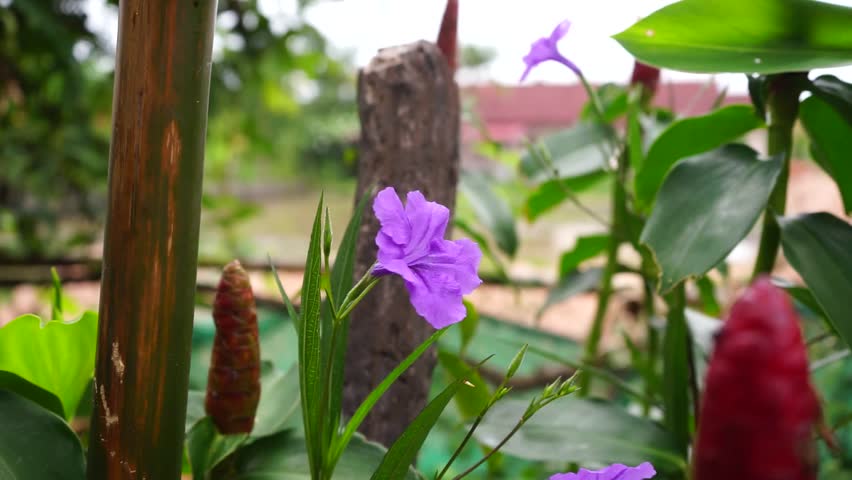

In September or October, boxes with an indoor tuberose flower must be brought into the house and left for storage in a dry cellar or pantry. You should not pick off the leaves of faded tuberose - they should dry out and fall naturally. As they dry out, nutrients from the dying veins will flow back to the root system.
Tuberose in landscape design


Spectacular tuberose looks great in both group and single plantings. To make the flower garden look brighter, you can plant various varieties of this plant nearby, differing in the color of the inflorescences. Polyanthes looks good next to gladiolus, the more you need to care for these crops in the same way.
Polyantes is used in rabatas as a background for low-growing horticultural crops. A tub with a flowering bush can be placed on a balcony, terrace, near a gazebo, etc. The inflorescences of such a perennial can be used for cutting, since they retain their freshness for about two weeks. But remember that they have a very strong smell, so it is better to keep the flowers in a well-ventilated room.
Essential oils are extracted from tuberose. They are used for the manufacture of perfumery products.
How to stimulate the root system?
In order to stimulate the germination of the root system in young tubers, it is recommended to first warm them well. To do this, just split the onion in two and leave it in a warm place. The air temperature in a dark room should be at least 25 ° C. As soon as the first roots appear, tuberose can be considered ready for planting in the ground.
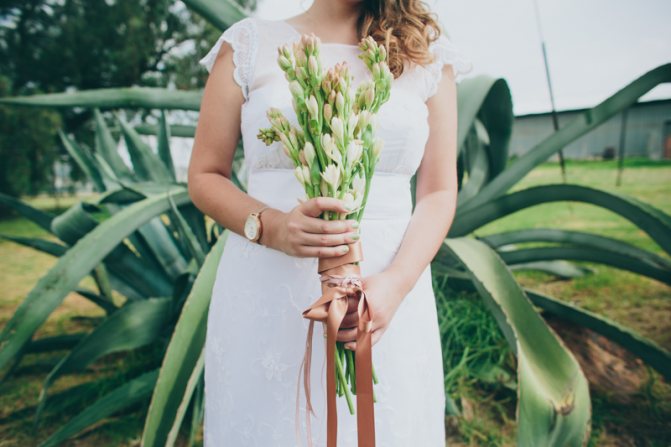

To stimulate the development of the root system, you can additionally use a special solution, which you can find in any flower shop in your city. In a mixture of "Zircon" and "Kornevin" the bulbs are kept for 12 hours, but if you purchased another preparation, be sure to read the instructions that you will find in the package.The bulbs must be positioned so that they are only 1/3 of the solution in the solution. Soon the biostimulator will do its job, and you will see the first young roots.
How to properly grow tuberose
Growing a thermophilic exotic plant is not easy, but worth it. The flower can be planted in greenhouses, conservatories, open field and pots. Tuberose is very demanding in terms of temperature and lighting. The flower needs alternating periods of vegetation and rest.
Temperature conditions
The flower is very demanding on temperature conditions. If the temperature drops below + 15 ° C, the plant dies. Such thermophilicity is due to natural growing conditions, where the thermometer almost never drops below + 17 ° C.
If you want to grow a plant at home, then you should take into account that the period of active growth should coincide with the stabilization of the warm temperature in the room.
Lighting requirements
Tuberose does not tolerate poor lighting. If your windows face the north side or they are constantly shaded by other houses or trees, then it is better to abandon the idea of growing this exotic flower.
Tuberose does not react well to the bright summer sun. In order for the plant not to get sunburn, it is necessary to create partial shade. For this purpose, we take plain white paper and obscure the glass. With the onset of the hot season, it is necessary to increase watering. It is necessary to prevent the earthen coma from drying out in the pot.
Humidity
Tuberose does not tolerate dry air very well. The optimum moisture content for a plant ranges from 50 to 80%. On very hot days, the flower must be sprayed with a spray bottle, provided that the plant is in diffused light, otherwise the flower will get leaf burns.
Watering
It is recommended to water tuberose every other day. It is recommended to use soft settled water for irrigation. If after watering a lot of water has collected in the pan, then the excess must be drained. Fluid stagnation leads to the development of various diseases. If the plant is on the sunny side in the warm season, then it needs abundant watering.
Review of biological products for plant protection
Pruning
This manipulation must be carried out if the plant is planned to be sent to forced dormancy. Pruning tuberose is necessary in the following cases:
- If the flower was taken care of incorrectly. The first sign of improper care is that the plant is stretching tall. If an exhausted plant blooms, then it may die. In order to avoid complete drying, it is necessary to completely cut off all the leaves, stop feeding and watering. Then send the bulb to a forced rest in a dark place.
- With the onset of the autumn season, the leaves of tuberose turn yellow and dry out. In order for all the nutrients to be used profitably and go to the bulb, and not to the leaves, the ground part of the plant is cut off and watering is stopped.
Growing seedlings
Tuberose is easy to grow both in a room atmosphere and in open field conditions. The plant is a very thermophilic crop, which must be taken into account during planting and during development. Most novice florists make elementary mistakes when choosing a site or placing a flowerpot with a young plant, leaving the flower in the sun. The most rational way would be to plant the tubers in the soil, which warms up to 10 ° C. Too hot ground will harm the polyanthes root system.
The most effective method for growing tuberose in indoor conditions is the container method of keeping. If you follow this particular method, you will achieve flowering of tubers early enough and you will not have to deal with annual flower transplants from one flowerpot to another.
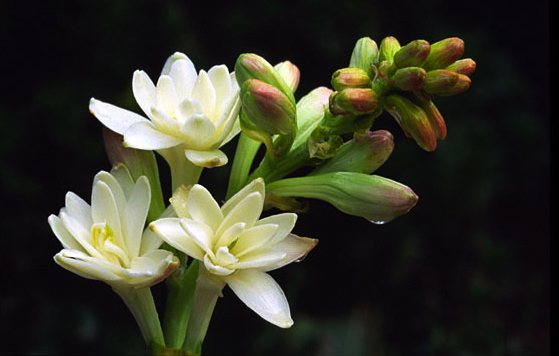

Bulbs are grown in the spring (May-April). Planting material is embedded in the soil no more than 1-3 centimeters. After only 3-4 weeks, the first shoots of the ornamental plant can be observed. The distance between adjacent specimens should be at the level of 15 centimeters. This will allow the young plant to take more space for the normal development of the root system.
When choosing a site, you should pay special attention to the structure of the soil. The soil must be fertile and light without fail. To achieve these goals, you can form a special sand pillow on the prepared place. This will also improve the quality of the drainage layer, as the plant does not like too much moisture at the roots.
Features of tuberose
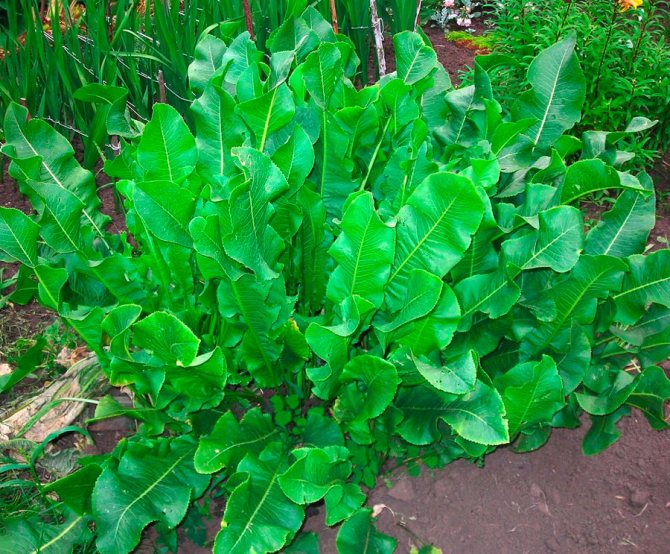

Tuberose is a herbaceous perennial and is highly decorative. The bush has a bulbous cone-shaped tuber, the surface of which is covered with dense small brown scales. In diameter, these scales reach from 20 to 60 mm. At the bottom of the bulbs there are thin filamentous roots. The life span of a corm is from 1 to 2 years. During this period, foliage, stems appear, after which the formation of buds is observed. When the flowering of the bush ends, the adult bulb dies off, while several young children remain in its place.
The height of the erect, slender stem is about 0.9 m. Dense sessile and narrow leaf plates can reach about 0.4 meters in length, and up to 30 millimeters in width, they are colored dark green and have a rough surface. Their formation occurs in the lower part of the stem.
During flowering, a spike-shaped inflorescence is formed at the top of the shoot, which includes from 10 to 40 buds. Tubular flowers reach about 50 mm in diameter and up to 60 mm in length. Pinkish, smooth and dense petals at the tops are pointed. The opening of the buds occurs alternately, and the first to bloom are those that are in the lower part of the inflorescence. Each of the flowers, after opening, dies off after three days. The inflorescences have a pungent but pleasant scent. Flowering is long, and it is observed from July to October. In place of wilted flowers, fruits are formed, which are oblong-oval-shaped capsules, inside which there are very small flat-shaped seeds.
Most often, this perennial plant is cultivated in indoor conditions, and a well-lit windowsill is chosen for it. In mid-latitudes, this flower is often grown outdoors as an annual plant. Species and varieties with double flowers are especially popular.
Pest control
The first sign that insects have attacked your green pet is the appearance of spots of a different color on the foliage. You can get rid of most pests with insecticidal preparations, for example, "Vertimek" or "Aktara". However, before you resort to using chemicals, try one of the folk remedies for pest control.
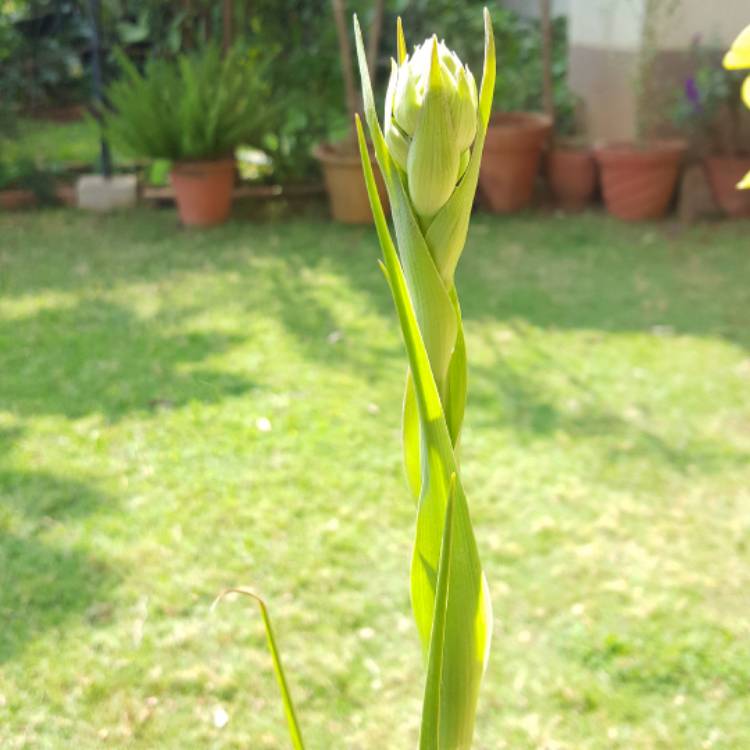

For example, spider mites can be dealt with by spraying the leaves with soapy water, and smokers, if there are any in the house, will help against aphids. Just cover the flower tightly with a jar, first letting in a little tobacco smoke under it. By morning, there will be no trace of insects.
Planting and leaving
In the warm regions of our country, these tuberous plants are grown without digging out of the flower bed every autumn. Therefore, tuberoses are common in these areas. But in other regions, where winters are quite cold, growing tuberose is not an easy task.In such areas in the fall, at the end of flowering, the tubers are dug up, washed in running water, dried and stored until the next season in a cool room with an air temperature of + 10 ... + 12C. Best placed in boxes filled with sawdust or sand. Leaves are removed when they are completely dry.... Children are separated from the tuber most often in the spring, when the corms are germinated.
Before planting in open ground, the corms are germinated, observing the following conditions:
- This should be done in mid-February.
- For germination, they are placed either in moss or peat.
- Germinated tuberoses should be kept in a dark but warm place.
- When the shoots appear on the bulbs (this usually happens 25 - 30 days after the start of germination), they are transplanted into containers with nutrient soil and taken out into a bright room, as well as regular watering.
- When the air temperature outside rises to + 18 + 20⸰С, containers with tubers are taken outside, where they are kept in partial shade.
- After 10-14 days, the germinated tuberose is exposed to a sunny place.
Sprouted tubers can be planted on flower beds no earlier than the third decade of May, when the probability of spring frosts will pass. When planting corms, make sure that the neck of the bulb is above the ground.
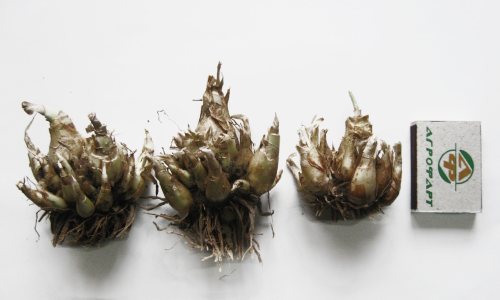

Tuberose tubers
The landing pits are dug shallow, a layer of sand is poured onto the bottom (6 - 8 cm thick). Sand is a drainage material through which excess moisture leaves faster when watering, without accumulating at the bottom of the hole. Excessive moisture accumulating in the soil leads to rotting of the root bulbs, and as a result - to the death of the plant. It is the florist's task to prevent this from happening.
The place for planting these flowers is chosen sunny, without drafts and gusts of wind, the soil is nutritious, also do not allow stagnation of water in the ground. Transplantation into prepared tuberose planting holes is well tolerated. But these plants grow and bloom well in slightly shaded areas, as well as in areas with diffused light. In sunny areas, tuberose is watered more often.
Watering tuberose
Watering should be regular, but not plentiful. Moisture should not stagnate in the soil, and the water for irrigation should be warm enough. Take into account the climatic conditions of the area - in hot weather, the number of waterings is increased, and during the rainy season, watering is stopped altogether.
Plant feeding
These flowering perennials should be fed several times per season.
These flowers are very fond of organic matter, as well as mineral fertilizers. But it is better to alternate these two types of fertilizers.
The first time the flower is fertilized before the buds appear, but not earlier than two weeks after the plant is transplanted into the open ground - tuberose takes root in new conditions and acclimatizes. The next feeding is carried out during the period of active flowering. And the last top dressing is applied to the soil after flowering.


Tuberose bouquet
The lack of nutrients immediately affects the general condition of the plant. This perennial can stop flowering, the foliage dries and curls for no apparent reason, and then falls off.
Home care
Although the plant is considered resistant to most types of known diseases, it is impossible to forget about the rules of care. It is carried out in several stages:
- Watering must be carried out with warm water as the earthen coma dries out. Care should be taken to ensure that moisture does not accumulate at the roots, otherwise this can lead to their decay.
- Top dressing is done with complex fertilizers. Do not overdo it with nitrogen, as a large amount of this substance can lead to lodging. But polyantes treats organic matter very well.
- Tuberose loves freedom, so spacious flowerpots with soil should be used.
If you follow the basic rules of care and planting, you will eventually get a beautiful ornamental plant.As a result, you will be able to enjoy the refined and incredibly exquisite scent of the tuberose flower. A photo of a beautiful plant will most likely encourage you to have one in your home. In addition, it has calming properties, which is most important for people with a diseased nervous system.
Tuberose care
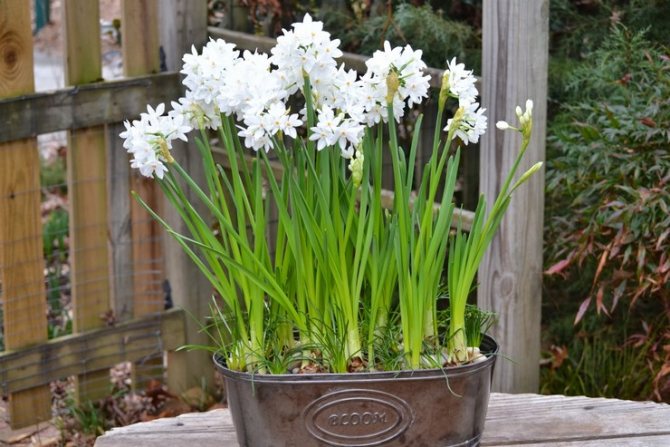

Caring for tuberose is quite difficult, the plant reacts sharply to all kinds of changes. However, the effort spent on growing a flower will definitely bring results. Tuberose will reward you with beautiful and abundant flowering and fill the garden with a fragrant aroma.
Location and lighting
Without bright diffused light, the plant will quickly lose its decorative effect. During the midday sun, the pots are placed in the shade to avoid burns on the leaves. In the morning and in the evening, the rays touching the leaves are harmless to the flower. If the pots are in the shade, the bushes will practically stop blooming.
Temperature
The perennial is kept warm, away from drafts and the air temperature is maintained within + 20 ° C, otherwise the budding process will be disrupted, and the growth of the culture will slow down. Low temperatures lead to the death of the plant. In the summer months, the tuberose flower is allowed to be grown outdoors, on balconies and verandas.
Watering and spraying
Air humidity should be no more than 80%. Spraying the foliage is recommended to be done daily, but it is important to take into account the fact that splashing water can provoke burns, so the procedure is best done in the absence of the sun.
Watering tuberose is provided in moderation, they use settled and purified water, heated to room temperature. If the soil is well drained, moisture will not accumulate in the root zone, but will be absorbed evenly by the entire surface of the substrate. Stagnation of water near the tubers leads to decay and death of the plant.
Top dressing
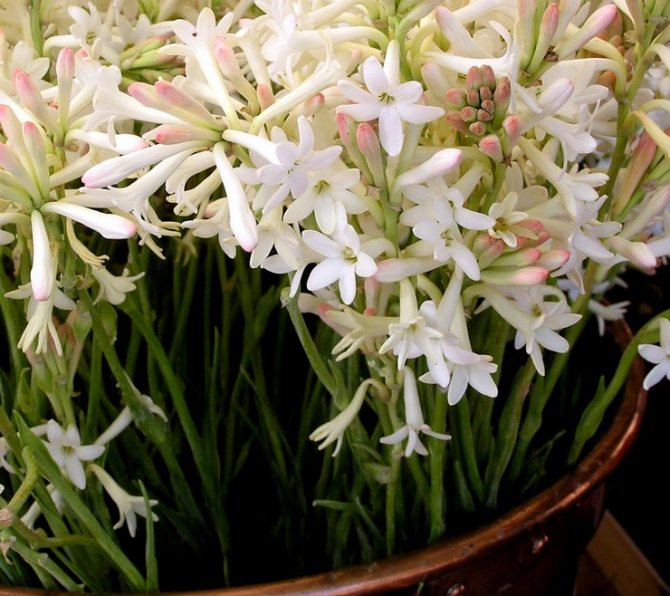

For active growth of green mass and bright flowering, tuberose is periodically fed. Dissolved mineral complexes and organic matter fertilize the soil every month, from May until the end of the growing season.
Dried inflorescences and deformed leaves must be removed from the shoots as they grow. Adult bushes are tied up so that the stems do not break in the wind, and the drooping and wilted processes are cut off. After the ground part dies off, the bulbs go into hibernation mode.
How to distill
Forcing tuberose tubers is best done a few weeks after digging up. They are laid out in a bright place and sprinkled with water. For planting tuberose, compact pots are chosen and garden soil mixed with sand is poured into them. Green sprouts soon appear. After six months, the mature seedlings will be able to bloom.
Follow-up care
If you have already planted Gladioli on your site, then you are probably familiar with caring for such a plant, and care for Tuberose is no different. All the steps for caring for these plants can be combined. If you do not have any experience in growing garden flowers, then you need to heed the following tips.
The soil must have a good drainage layer, this plant does not tolerate stagnant moisture. It is better to use fertile and well-permeable soil, and the area for planting should be well lit by the sun. Diffused light is also suitable for Tuberose. The main conditions are the absence of winds and a sufficient amount of light.
Watering will depend on the intensity of sunlight, the more the area is flooded with sunlight, the more often the plant will have to be watered. It is necessary to water the flower regularly, but without fanaticism, overflow will immediately lead to decay of the roots.
Read also: Features of planting asarina climbing
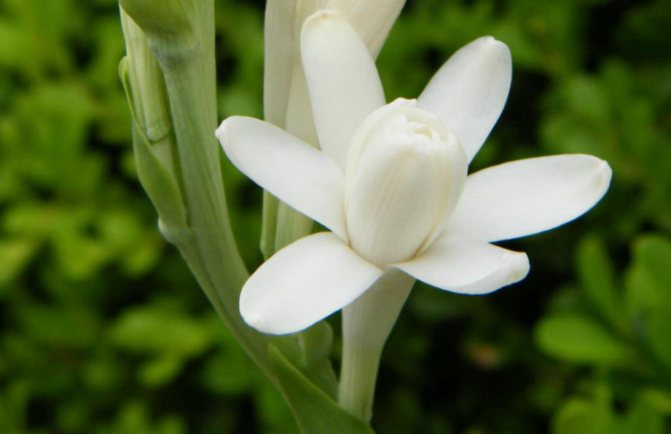

For irrigation work, it is better to use a warm liquid, then the plant will reward you with strong and lush flowers. If it rained for a long time, watering should be stopped for a while.
Top dressing for this flower will not be superfluous, it not only responds perfectly to fertilizers, but also needs them. Mineral and organic compounds are suitable. During the summer season, feeding will be needed 3 times with an equal interval of time in between.
If Tuberose does not have enough fertilizers, it will definitely let you know about it, the foliage will begin to fall off, and you will not wait for a beautiful flowering. It is worth noting that mixtures with a large amount of nitrogen will make the flower look ugly, the stem will stretch out, and the plant can lie on the ground.
More details about leaving in the video:
In the open field, Polyantes grows quite well if you follow all of the above rules for keeping the plant.
In addition, the flower is highly resistant to diseases and pests due to its bright aroma. However, aphids and thrips are sometimes uncomfortable. You can cope with them with the help of special drugs.
Origin and description of the flower
Its homeland is Mexico, from where it was brought back in the 16th century, at the same time the first description of tuberose was made. Polyantes (Greek for "brilliant flower") belongs to the agave subfamily of the asparagus family, with a total of 13 species.
Tuberose gained the greatest popularity in the 19th century, in which it was praised not only by gardeners, but also by poets in their works. Now this flower is experiencing its rebirth, surprising everyone with its beauty and enchanting aroma. A very expensive extract, which is obtained from its flowers, is used in the manufacture of world-famous perfumes and "Dior", essential oil and aromatic sticks are also produced.
This is a perennial plant with a bulbous tuber at the base of a powerful root system and several basal leaves collected in a rosette. The height of an adult stem can reach 50-100 cm, and the height of the leaves is 30-40 cm.
In Russia, polyantes in open plantings is used in the southern regions (Crimea, Krasnodar Territory). However, in the central regions, including in the Moscow region, amateur gardeners are successfully cultivating it.
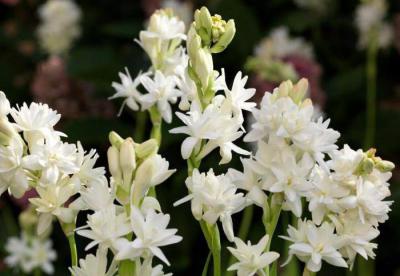

Tuberose reproduces mainly by tubers, the service life of which is 2 years: in the first, the plant should grow well and acquire leaves and shoots, and in the second year, flowering occurs, after which the maternal tuber dies, but gives life to many children.
Flowering time begins in July and lasts until October. Flowers located on top in the form of a spike with many inflorescences (up to 30 pieces) have dense waxy petals. The size of the flowers is 5-6 cm in length and 3-4 cm in diameter. When the buds open, they emit a very pleasant and strong smell. For several centuries, as a result of selection, various forms and shades of flowers have been bred: double, pink, yellow, purple, salmon and lilac.
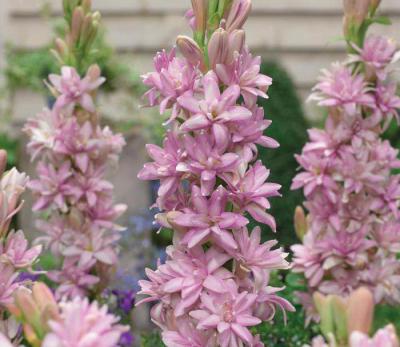

Flowers on one stem begin to bloom starting from the bottom of the peduncle. Tuberose, which is properly planted and cared for in the open field, blooms for almost 3 weeks, retaining its beautiful decorative appearance and smell. If the flowers are cut, then in a bouquet they can stand for almost 2 weeks, and when vinegar is added to the water, even longer. After flowering, a box with flat seeds is formed.
Reproduction
During the season, the corm forms many children (up to 20 pieces), their size depends on nutrition and other conditions. In the middle of summer, young plants can be separated from mother plants. From them, by the end of the season, they receive a full-fledged planting material that can bloom next year. But it happens that flowering occurs only in the 2-3rd year. It is not necessary to do this, the children can be removed after digging.
Children are not separated from the dug corms prepared for storage. There is a danger of drying out. This is done only in the spring before planting and then only when necessary. Some growers advise not to disturb the natural harmony by planting the nest of bulbs, as it is, entirely. This is not true, sinceeach child does not even bloom, forms its own children. As a result, the corms lack space and nutrition, and they grow poorly.
Growing tuberose from seeds is possible only in specially created conditions, in regions with a warm mild climate.
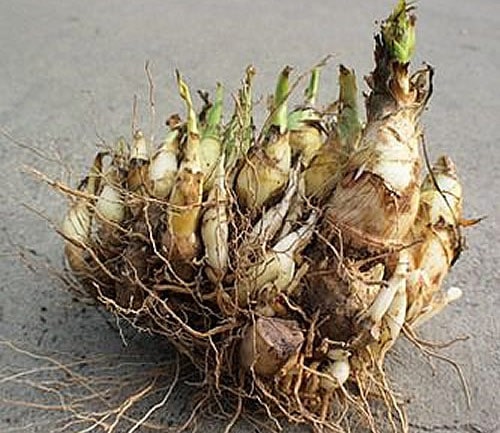

Tuberose corm with babies
How to ensure the control of diseases and pests when growing tuberose in the open field?
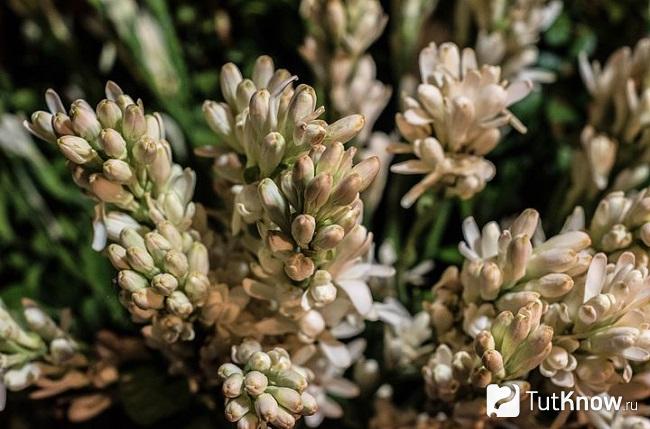

Since the Ratkirani plant contains essential oils, their aroma tends to repel most of the harmful insects. The biggest problem for tuberose is the bears and their larvae, which gnaw the roots and lead to the death of the entire bush. Both chemical and folk remedies are used to destroy pests. As the first, you can use the drug Medvetox, and among the people, the bear is destroyed by watering the soil with a solution based on bird droppings and water, or strong-smelling plants, such as chrysanthemums or garlic, are planted nearby.
If a large amount of nitrogen was added during top dressing, then this can lead to tuberose damage by spider mites or slugs, since the deciduous mass will grow very much. The first pest should be used when processing systemic insecticides such as Kleschevita, Fitoverma or Aktara. Gastropods are eliminated using means such as Meta-Thunderstorm or sprinkled with wood ash or crushed eggshells on the surface of the soil, which will prevent the pests from moving.
Also a problem in the cultivation of tuberose is aphids, which multiply in large quantities and such small greenish bugs actively suck out nutritious juices from the leaves and stems of the plant. Also, aphids can become a carrier of viral diseases, which cannot be cured, and all plantings must be removed. For control, insecticidal agents are also in use, for example, Actellik or Karbofos, or you can spray the plants with a solution based on laundry soap.
The main diseases affecting tuberose are:
- fusarium,
in which the leaves curl at the same time, their tips turn yellow; - gray rot,
affecting corms and stems. The first ones become soft and blacken, and spots of brown color form on the stems.
To combat such fungal diseases, tuberose should be removed from the soil, all affected parts should be removed and treated with fungicides (for example, Fundazol or Bordeaux liquid) and slightly dry the bush. As a preventive measure, it is recommended that when planting in the substrate, add a couple of peas of the drug Trichodermin, which will serve as protection against diseases caused by fungi and will increase the rooting rate.
Also, when growing tuberose, the following problems may arise. On the advice of some gardeners, after digging the corms, the children are not separated from them. However, in the future, this will weaken the mother's bulb, since young formations will draw juices from it for their growth. Still, it is better to carry out a separation after digging and store all sorted corms separately. With the arrival of spring, planting should be carried out separately for each bulb, and not for a whole bulb nest.
Real Disembarkation Tips
As a rule, tuberose is not planted directly in open ground due to the excessively cool climate in our latitudes. First of all, tuberose tubers are germinated at home, in a warm environment. And only later they are transplanted into street conditions.
Below is an overview of the main questions: how to provide care and when to plant tuberose? In the photo - planting in open ground.
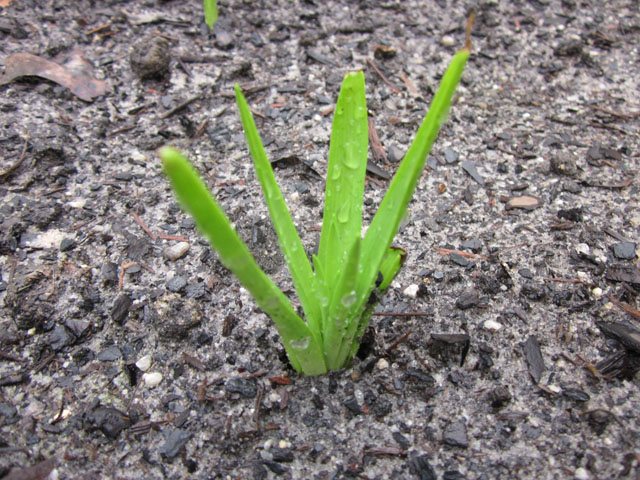

Flowers planted in prepared peat are placed in a warm room and the soil is regularly watered. It must be borne in mind that it is advisable to germinate tubers in the dark. After the first shoots are noticed, the seed is transplanted into pots with an earth substrate.The ideal time for transplanting polyanthes into open ground is not earlier than the end of spring, somewhere in April or May. In the photo - tuberose in the open field during the flowering period.
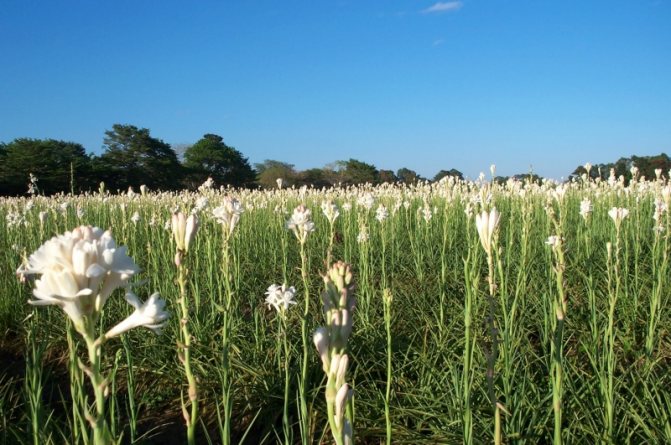

The last months of spring are the time when most of the territory of our country is warmed up by the sun's rays, the possibility of frost is excluded and warm weather stabilizes. One of the best periods for disembarkation is from 20 April to 10 May. This period of time is suitable for most of the regions of Russia, with the exception of the Far North and Siberia.
To successfully plant tuberose in open ground, care must be started with tillage in the garden bed. It is fundamentally important that the tuber is planted in a “cushion” of sand, which will provide future roots with excellent drainage, because the plant suffers and dies from stagnant water. Before placing the bulb in the open ground, be sure to treat the soil with fertilizer. Such an action will save the plant from potential diseases, as well as rotting of the root system.
When transplanting tuberose into open ground from home conditions, the roots are immersed approximately 1-2 cm. Usually, polyantes transfers the transplantation positively, therefore difficulties should not arise at this stage. Placing tubers in the soil, it is allowed not to cover them with soil from above: tuberose will take root even without special deepening.
Scent
In many countries, the name of tuberose is associated with the exuded fragrance: the night queen, the queen and the queen of fragrance. It is natural that her essential oil is widely used in perfumery for the composition of male and female perfumes, perfumery and eau de toilette by famous companies:
- Lancome - Climat, Magie Noire, Roeme;
- "Dioir" - "J'adore", "Miss Dior", "Poison";
- Chanel - Gabrielle, Anais Anais;
- Givenchy - Amarige;
- Gucci - Bloom Acqua di Fiori, Flora;
- "Slava Zaitsev" - "Maroussia".


The most interesting thing is that the description of the smell cannot be expressed in a few words: it changes during the day, intensifying at night, and you can catch notes of narcissus, honey, fruit, gardenia in it. Fragrant breath can be heard at a distance of 15-20 meters.


Transplant and reproduction
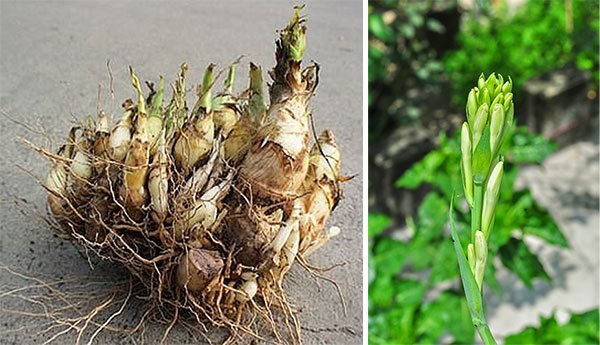

Tuberose is very poorly tolerated by frequent transplants and reproduction. If these manipulations are carried out at the beginning of the growing season, then the tuber may die.
Landing takes place in April. A tuberose bulb can only be transplanted if it has not been transplanted anywhere during the year. When the first green shoots appear, tuberose cannot be transplanted.
For a full life, a bulbous flower needs an alternation of the period of sleep and vegetation. At the beginning of autumn, a dormant period begins and lasts until March. With the onset of cold weather, watering is completely stopped.
After a dormant period and before the first spring watering, the tubers are taken out and divided. Only at the beginning of April, the flower completely painlessly tolerates the procedure. After separating the onion, it is advisable to hold it for a couple of hours in a weak solution of potassium permanganate. This is necessary to disinfect wounds.
When transplanting bulbs less than 2 cm in diameter, do not expect tuberose to bloom. For some time, the bulb will need to be grown to a certain size.
Video "Getting ready for planting tuberose"
Tuberose is a capricious plant that requires certain conditions to be met. But the beauty is worth it. If you devote a little time to the flower every day, then the result will not be long in coming.
Photo gallery of views
How to store a flower in the winter?
When the tuberose has faded, a seed capsule is formed in October, then it is necessary to dig out the flower bulbs from the ground. The harsh winter of our climate will not give the gentle polyanthes a chance to survive. Therefore, at the time of frost, the bulbs of the plant will be stored separately from the ground until the onset of spring sunny days.
Thus, in the fall, before the onset of frost, the tubers are carefully dug out of the soil, rinsed under warm running water, and easy disinfection is performed. Then the bulbs are dried, stored in a dark, dry place until the next spring. Storage temperature - approximately +10. +15 degrees. It is necessary to store polyanthes tubers among sawdust or in dry sand. The leaves are removed from the stem only after they are thoroughly dried.For storing tubers, an underground floor is ideal, where winter preparations and vegetables are kept.
Tuberose - how to grow a "night gladiolus"?
Adding an article to a new collection
Many gardeners dream of growing tuberose on their site. But in order for the plant to please with abundant flowering, you will have to pay special attention to it.
Tuberose Is a surprisingly beautiful tuberous perennial plant native to Mexico. For its pronounced sweet and rich smell in Asian countries, it is called the "queen of aromas" or "queen of the night".
Outwardly, tuberose looks very attractive. Its narrow, oblong, pointed upward leaves have a bright green tint. Spike-shaped racemes of large flowers are arranged on slender tall stems. The petals are elastic in texture and somewhat resemble waxy or porcelain. An adult plant usually blooms from 15 to 30 full-fledged buds. They open gradually from the bottom up and delight with their flowering for 14-20 days.
In nature, only snow-white tuberoses are found, however, breeders have managed to bring out unusual terry varieties of purple, cream, lilac and pale pink shades.
Blooming period of tuberose - 2-3 weeks
Using
Polyantes is used to create mixed flower beds, planted next to gazebos or under the windows of a house (on the sunny side).
The plant is suitable for distillation, but after distillation, the corms are thrown away, because the plants do not bloom in the future. Polyantes is suitable for cutting, keeps the bouquet fresh for about 2 weeks.
Tuberose is grown as a pot culture, for gardening gazebos, verandas, terraces, balconies. It is not recommended to bring the polyanthes pot into the living area, as the strong scent of the flowers can cause headaches.
Views
More than 10 types of polyanthes are found in nature, but only two of them are used in gardening.
Broadleaf
The variety belongs to a perennial group of plants. The flower bulbs grow in the form of a cone up to 6 cm long and 3.5 cm in diameter. The stem is powerful, straight, up to one meter high. The root zone of the stem is densely covered with wide leaves of bright green color. Inflorescences are formed in the form of an ear. The flowers are large, up to 46 mm in diameter, of a snow-white shade with a faint, delicate odor.
Tuberous
All varieties of this variety of tuberose stretch upward to 97 cm. The variety of a flower reproduces with large bulbs. Leaves up to 48 cm high germinate from them, similar to the leaves of cereals. The stem is erect, strong. The flowers are arranged in pairs, forming an ear. The inflorescence contains up to 28 flowers of a snow-white color of a tubular appearance with a strong sweetish aroma.
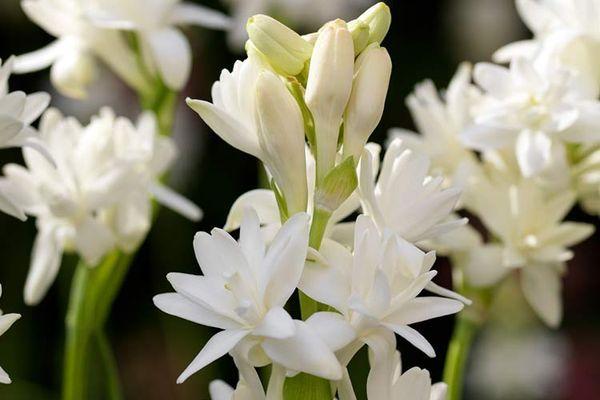

Care
After planting, the plants provide decent care, which consists of the following steps:
- Watering... Since tuberose is considered a heat-loving flower, you need to water it with warm water. Water regularly, as the earthen coma dries out. But you need to make sure that moisture does not accumulate, otherwise the root system will rot, which will negatively affect the corms.
- Top dressing... Complex fertilizer is used as fertilizer for feeding. You can not overdo it with nitrogen, as they will oppress the plant and lead to its lodging. Reacts well to organic fertilizers. It is better to apply it twice a season, after planting and before flowering.
- The flower should not be allowed to thicken with other plants. Tuberose loves freedom.
If you decide to buy flower tubers, then you need to choose the largest ones, since small bulbs, less than 2 cm in diameter, may not throw out the peduncle in the first year.
It should also be remembered that after digging for winter storage, the tubers of the flower should be dormant for some time, at least one month. Only then do sprouts begin to germinate.
Agrotechnics
For full development, first of all, compliance with dormancy, forcing and planting conditions is required. Further care differs little from caring for other colors:
- does not tolerate drought and excessive watering. A good option: plant a ground cover plant around the bushes that will retain moisture;
- responsive to feeding during budding and flowering. Fertilization is stopped after flowering;
- the stems must be tied up so that they do not break from gusts of wind or under the weight of peduncles;
- regularly remove faded flowers.
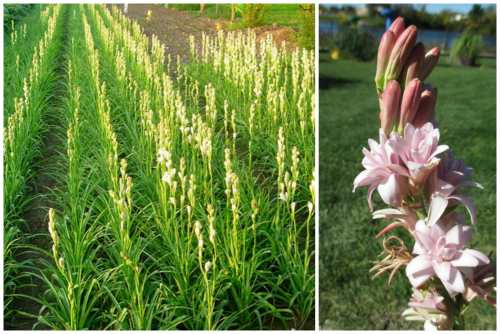

Pests and diseases
A native of Mexico is saved from pests by its persistent smell: it repels many insects. Rare pests - spider mites, aphids and a bear, use appropriate preparations to combat them.
Good immunity prevents diseases, but with an excess of nitrogen in the soil, prolonged rains and thickening, the tubers can be affected by gray rot, which is very difficult to get rid of. To prevent the disease, it is recommended to treat the tubers before planting with drugs such as Fundazol and Fitosporin.
In perfumery and cosmetics
Gardeners appreciate polyanthes for its decorativeness, and perfume houses for its delicate and refined aroma. The tuberose note is the base of numerous famous and legendary perfumes.
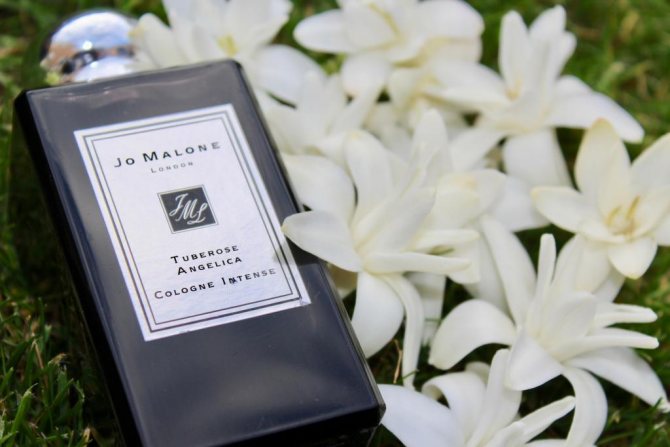

Curiously, certain plant species emit such an intense odor that it can provoke a headache.
With the exception of perfume compositions, polyanthes petals are also used to create a special essential oil. Esters of tuberose are endowed with phenomenal properties. The product is considered one of the most expensive types of cosmetic products. The flowering of polyanthes lasts quite a long time, until late autumn, approximately from July to October. This is another significant reason for the high popularity of tuberose among gardeners.
How to care for polyanthes?
If handsome gladioli are already sprouting in the garden, then planting and caring for tuberose in the open field will not be new, because the actions are almost the same. If there is no experience in following the flowers, then the following recommendations must be taken into account:
- The soil for planting must be well-drained, because polyantes does not tolerate sticky soil.
- For the successful cultivation of flowers, you need fertile, loose land and a garden area filled with sunlight.
- If there is no warmest place for planting tuberose, then it is allowed to plant polyantes in the ground with diffused lighting.
- It is important that there is no open wind on this piece of land.
- A delicate flower needs enhanced lighting. Gloom and shade are not for polyanthes. The exception is midday open ultraviolet rays; it is better to protect the flower from such an effect by shading with something at this time.

